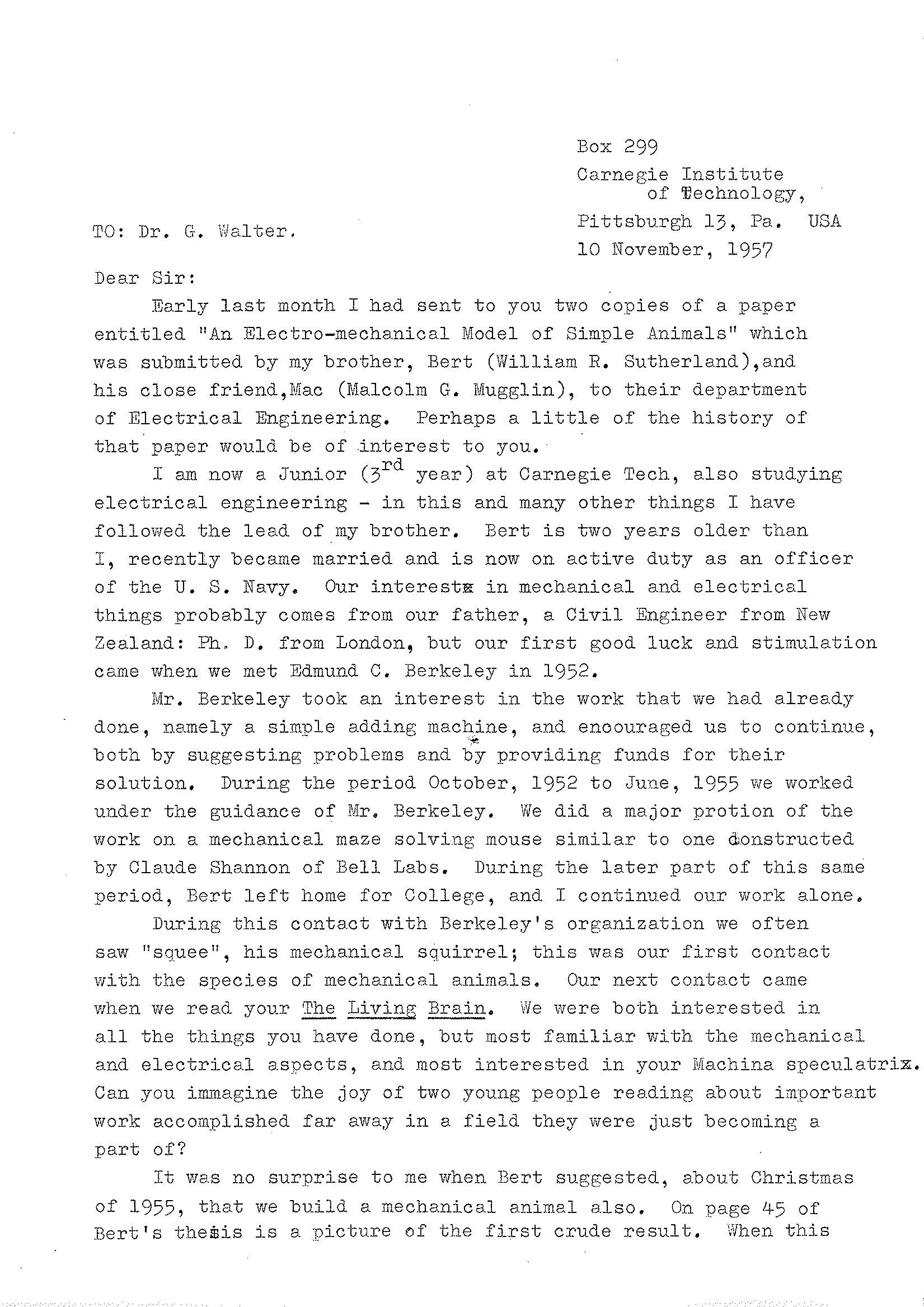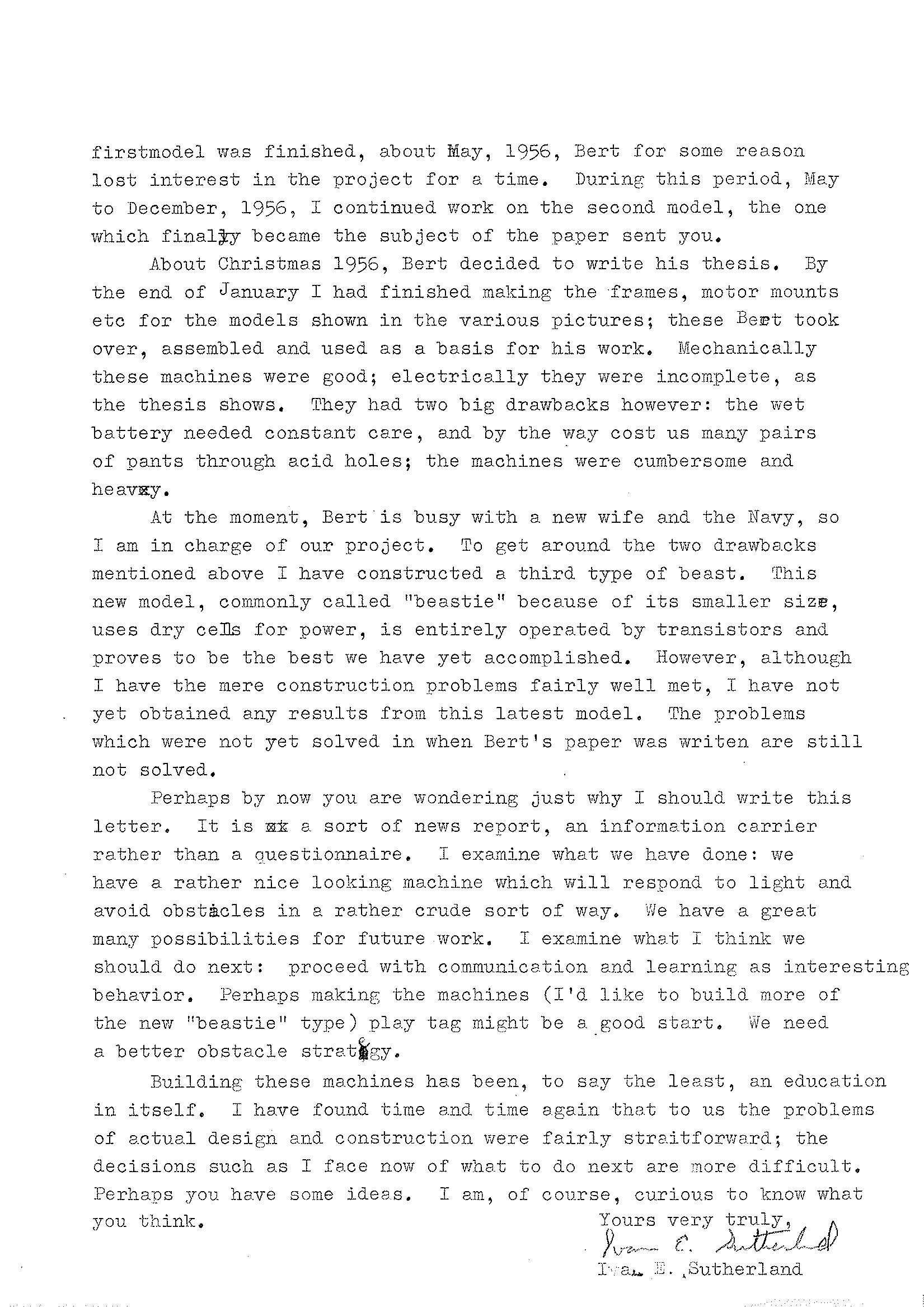This copy of a letter from 1957 describes the first "Mechanical Animal" built by the Sutherland brothers, Bert and Ivan.


Here’s a transcript of the letter sent from Ivan E. Sutherland to Grey Walter in 1957:
Nov 10. [IES to WGW]
“Dear Sir:
Early last month I had sent to you two copies of a paper entitled “An Electro-mechanical Model of Simple Animals” which was submitted by my brother, Bert (William R. Sutherland), and his close friend, Mac (Malcolm G. Mugglin), to their department of Electrical Engineering. Perhaps a little of the history of that paper would be of interest to you.
I am now a Junior (3rd year) at Carnegie Tech, also studying electrical engineering – in this and many other things I have followed the lead of my brother. Bert is two years older than I, recently became married and is now on active duty as an officer of the U.S. Navy. Our interest in mechanical and electrical things probably comes from our father, a Civil Engineer from New Zealand: Ph. D. from London, but our first good luck and stimulation came when we met Edmund C. Berkeley in 1952.
Mr. Berkeley took an interest in the work that we had already done, namely a simple adding machine, and encouraged us to continue, both by suggesting problems and by providing funds for their solution. During the period October, 1952 to June, 1955 we worked under the guidance of Mr. Berkeley. We did a major protion [sic] of the work on a mechanical maze solving mouse similar to one constructed by Claude Shannon of Bell Labs. During the latter part of this same period, Bert left home for college, and I continued our work alone.
During this contact with Berkeley’s organization we often saw “squee”, his mechanical squirrel; this was our first contact with the species of mechanical animals. Our next contact came when we read your The Living Brain. We were both interested in all the things you have done, but most familiar with the mechanical and electrical aspects, and most interested in your Machina speculatrix. Can you imagine the joy of two young people reading about important work accomplished far away in a field they were just becoming part of?
It was no surprise to me when Bert suggested, about Christmas of 1955, that we build a mechanical animal also. On page 45 of Bert’s thesis is a picture of the first crude result. When this first model was finished, about May, 1956, Bert for some reason lost interest in the project for a time. During this period, May to December, 1956, I continued work on the second model, the one which finally became the subject of the paper sent [to] you.
About Christmas 1956, Bert decided to write his thesis. By the end of January I had finished making the frames, motor mounts etc for the models shown in the various pictures; these Bert took over, assembled and used as a basis for his work. Mechanically these machines were good; electrically they were incomplete, as the thesis shows. They had two big drawbacks however: the wet battery needed constant care, and by the way cost us many pairs of pants through acid holes; the machines were cumbersome and heavy.
At the moment, Bert is busy with his new wife and the Navy, so I am in charge of our project. To get around the two drawbacks mentioned I have constructed a third type of beast. This new model, commonly called “beastie” because of its smaller size, uses dry cells for power, is entirely operated by transistors and proves to be the best we have yet accomplished. However, although I have the mere construction problems fairly well met, I have not yet obtained any results from this latest model The problems which were not yet solved in when Bert’s paper was written are still not solved.
Perhaps by now you are wondering just why I should write this letter. It is a sort of news report, an information carrier rather than a questionnaire. I examine what we have done: we have a rather nice looking machine which will respond to light and avoid obstacles in a rather crude sort of way. We have a great many possibilities for future work. I examine what I think we should do next: proceed with communication and learning as interesting behaviour. Perhaps making the machines (I’d like to build more of the “beastie” type) play tag might be a good start. We need a better obstacle strategy.
Building these machines has been, to say the least, an education in itself. I have found time and time again that to us the problems of actual design and construction were fairly straightforward; the decisions such as I face now of what to do next are more difficult. Perhaps you have some ideas. I am, of course, curious to know what you think.”
CHALLENGE
I've tried to track down Bert Sutherland's thesis to obtain a picture and further details of this "beast", but without success. Maybe an American out there could find this information and I would happily publish it here. From the above article, the thesis was completed early 1957.
Thanks for the link, but I’m after Bert’s earlier Thesis, not his Ph.D. thesis that this link points to. I appreciate the effort, regardless.
http://dspace.mit.edu/handle/1721.1/13474